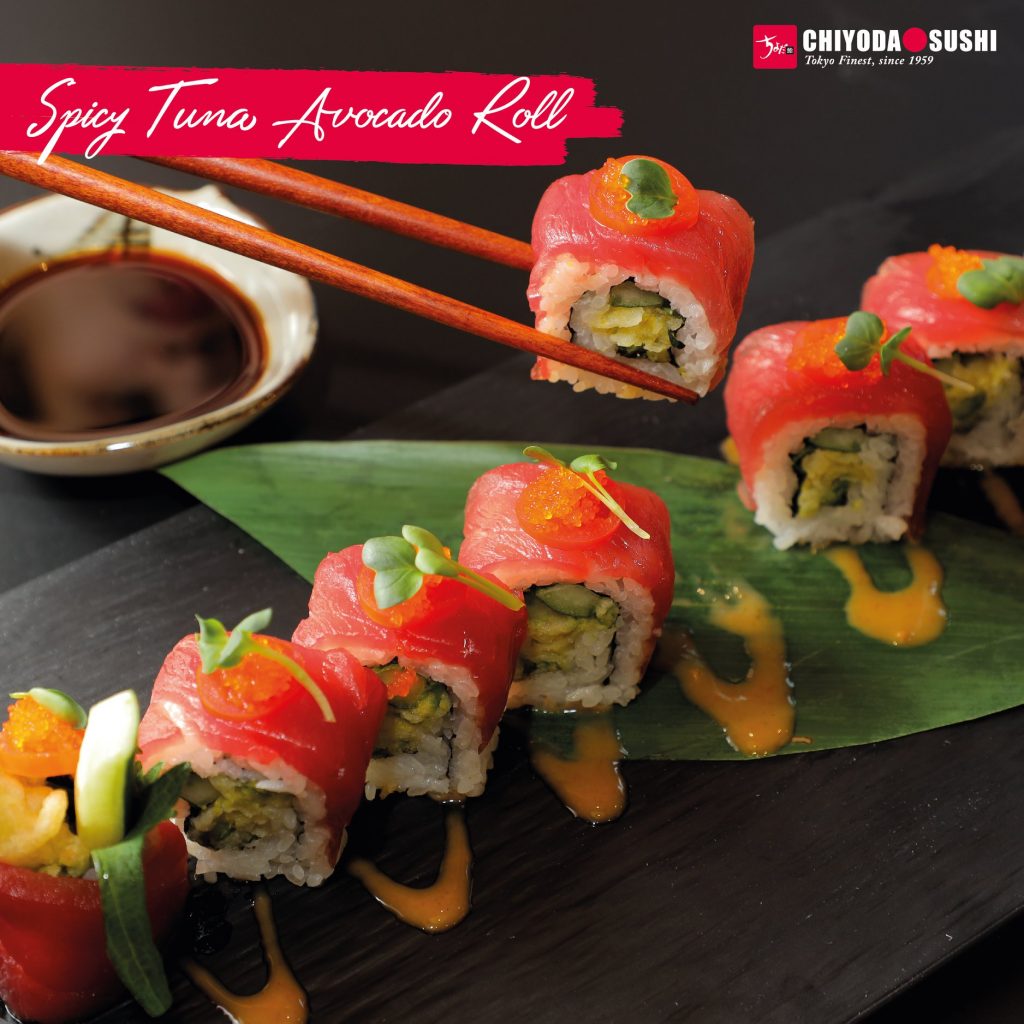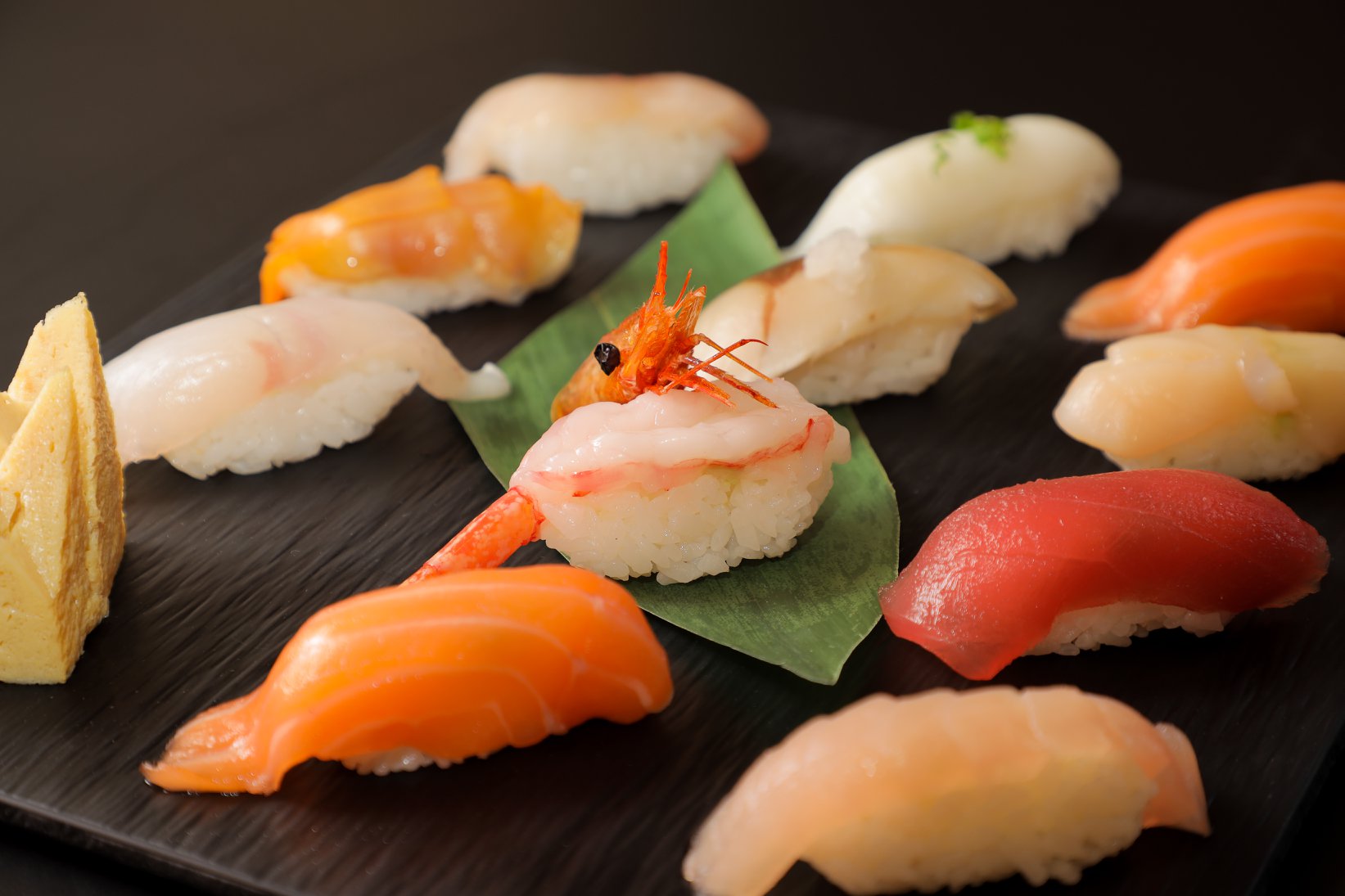
Sushi is the national soul food in Japanese culture. Ingredients to make Sushi are very diverse, from raw, cooked to unique each region. Depending on the taste, history and culinary culture that vary between regions and classes in Japan, Sushi also has many different types and forms. Let’s find out some popular types of Sushi in Japanese culinary culture with Chiyoda Sushi.
Although there are many types of Sushi, but basically, this is a traditional Japanese dish consisting of rice mixed with vinegar, seasoned with seasonings called Shari, combined with topping called Neta, which are fresh raw or cooked ingredients such as seafood, fish, meat, vegetables, omelet…. The dish is usually served with pickled ginger (Gari), Wasabi and soy sauce.
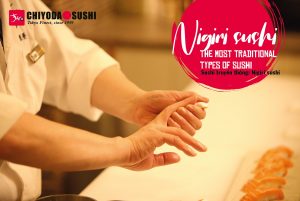
Chef Moriya Making Nigiri Sushi (Photo: Chiyoda Sushi)
Nigiri is the first and most basic form of Sushi that we know today. Nigiri Sushi is also known as Edo-mae Sushi (meaning “in front of Edo”), the name refers to the original place of the dish – Tokyo (formerly Edo). (Read more: Edomae Sushi – a unique highlight when thinking of Japanese cuisine)
Nigiri Sushi is made by holding rice mixed with vinegar in the palm of your hand and then topping it with different ingredients called Neta. This was considered as “fast food” and prepared by experienced Sushi Artists who worked in the Edo area in the 1800s to serve the workers a quick and full meal while working.
Neta can be seafood, fishes, vegetables, meat, omelette or tofu; Besides fresh raw ingredients, fishes and seafood can be soaked in soy sauce, vinegar or lightly grilled before being used. The top of the Nigiri Sushi could be brushed a thin layer of special sauce to bring out the flavor of the dish.
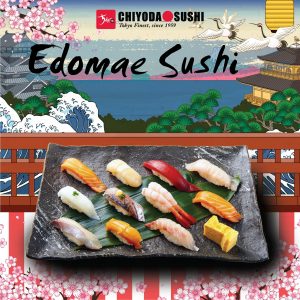
Nigiri Sushi – Edomae Sushi (Photo: Chiyoda Sushi)
Oshizushi (pressed Sushi), also known as Bozushi (boxed Sushi), is a unique shaped style of Sushi originating in Osaka. This variety is made by pressing Neta and Shari into an “Oshiwaku” rectangular box, then cutting the Sushi into interesting shapes like rectangles, triangle, or small squares. The toppings include fish like mackerel or gizzard shad, and with this unique display makes Oshizushi a popular choice for bento boxes and gifts.
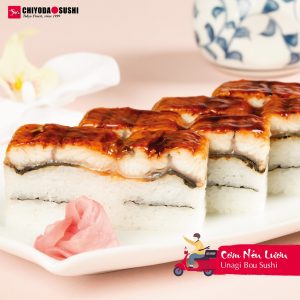
Unagi Bou Sushi (Photo: Chiyoda Sushi)
Chirashizushi is a bowl of rice topped with a variety of ingredients, with popular Neta including pieces of salmon, squid, cucumber, shredded omelet, and boiled prawns. It’s like a Kaisendon (Japanese rice bowl topped with a large amount of seafood), with the main difference being that Chirashizushi uses vinegared Sushi rice (Shari) whereas Kaisendon uses plain steamed white rice.

Salmon Avocado Chirashi (Photo: Chiyoda Sushi)
Makizushi, also known as “Norimaki,” refers to a type of sushi where Shari and Neta are carefully rolled in a sheet of nori seaweed, which is then cut into smaller pieces. With the technique of rolling all ingredients together, Japanese call It as “Makizushi” with “Maki” is “to roll”.
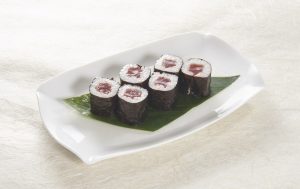
Hoso Maki (Photo: Chiyoda Sushi)
Long, thin rolls typically featuring just one ingredient like a strip of fresh tuna, cucumber, or pickled Daikon are called Hosomaki. Besides, Futomaki (futo means big, fat) is a thicker Makizushi with a Neta consisting of a combination of different ingredients.
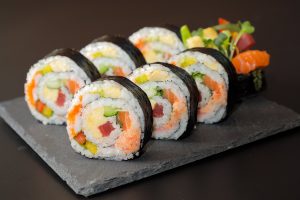
Futo Maki (Photo: Chiyoda Sushi)
Uramaki, often called “inside-out sushi”, is a modern version of Makizushi. It’s made by first layering the Shari onto the bamboo sushi mat, then laying the nori sheet on top followed by the remaining Neta, before rolling. It’s often rolled in sesame seeds, which easily stick to the exterior rice or topped with tobiko fish eggs for extra crunch.
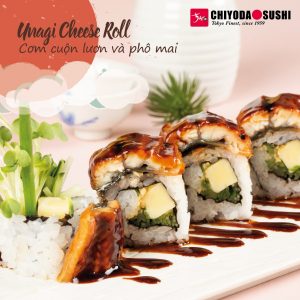
Uramaki (Photo: Chiyoda Sushi)
Gunkan maki is another type of maki—“rolled” or “wrapped” Sushi (Makizushi) —and was invented in a Ginza Sushi Restaurant in the 1940s.
The dish is made by wrapping a wide strip of Nori around a Shari ball while leaving enough space at the top to be filled with various Neta. The name, translated as “battleship” or “warship” Sushi, comes from its shape, resembling a tiny ship.
Popular Neta for Gunkan Maki include uni sea urchin, squid, salmon roe, Negitoro (a blend of fatty tuna belly and green onion), potato salad, and Kanimiso (blended crab brains).

Gundan Maki (Photo: Chiyoda Sushi)
Temaki is an interesting type of sushi with a shape resembling that of an ice cream cone. To make it, Shari and ingredients are held within a sheet of nori wrapped into a conical shape. Temaki can be enjoyed at restaurants as well as made at home because of its simplicity and ease of making; the dish has a variety of Neta, with some popular types including Umeshiso—a paste made of fresh Shiso leaf and Umeboshi (pickled plum), Negitoro, and sweetened omelet.
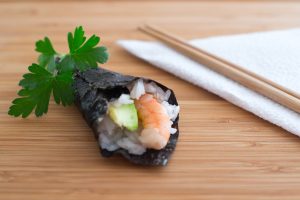
Temaki (Photo: Freepik.com)
In Japanese, “Sasa” is a bamboo leaf, and Sasazushi is the Sushi consisting of Shari and Neta wrapped in a bamboo leaf.
Sasazushi is thought to have come from the Nagano prefecture during the Warring States period (1467–1573), and differing documents say that its origin was because Nagano locals were looking for a dish to impress the visiting samurai warlord of the time, Uesugi Kenshin. Neta includes a wide range of wild vegetables such as mugwort and bamboo shoots, walnuts, mushrooms, miso, shredded omelet, and salmon. At the first look, it looks like Vietnamese sticky rice wrapped in a lotus leaf, doesn’t it?

Sasazushi (Photo: CC from Wikipedia)
Another type of pressed, leaf-wrapped sushi is Kakinoha-zushi, which comes from the Nara region of western Japan and dates to the Edo period. This version is wrapped in a persimmon (kaki) leaf instead of Baboo leaf. In the past, persimmon leaves were often used to wrap food to ensure freshness during transportation; The leaves not only preserved the fish with its antibacterial properties, but also gave it a delicate aroma, from that Kakinoha Zushi was born.
Kakinoha-zushi is most commonly made by placing salmon or mackerel on top of the Shari, but it can also feature other ingredients like prawn or eel. It’s a popular Omiyage (souvenir) for visitors to Nara region.
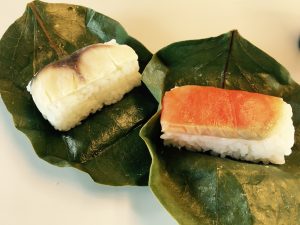
Kakinoha-zushi (Photo: CC from Wikipedia)
Fermentation was a traditional technique used on the world to preserve fish and other products for a long time. Nerezushi appeared in Nara period (710–794) is a special Sushi dish when its’ Neta is made from fishes fermented in salt and rice for months to years before being used.
Nowadays, Narezushi is generally less popular because of its extremely sepcial flavor. However, Funazushi of the Shiga prefecture remains popular, which is made using the Nigorobuna fish from nearby Lake Biwa. Because fish is incubated and fermented with sophisticated processing techniques for a long time, usually up to 5 years, the price of the dish is quite high…
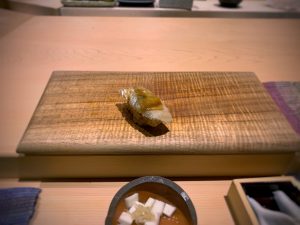
Narezushi (Photo: CC from Wikipedia)
Different from the types of Sushi mentioned above, common Inari-zushi does not contain any fish or seafood and is quite sweet in flavor.
Inari is a pouch-like piece of aburaage (deep-fried tofu) that has been simmered in a seasoning of Mirin, soy sauce, Dashi, and sugar. It’s named after the Shinto god, Inari, who is said to have had a fondness for tofu.
When Shari is filled in the Inari-pouch, the dish becomes Inari Zushi. Besides Shari, steamed rice mixed with vinegar, Inari Zushi can also be filled with rice mixed with other ingredients or rice topped with a range of ingredients like mushrooms, squid, boiled prawns, chives, or shredded omelet…
The versatility, ease of making, and portability of Inari Zushi makes it a popular item for bento as well as finger food for picnics and parties.

Inari Sushi (Photo: CC from Wikipedia)
Except for special Sushi dishes with geographical elements of each region such as Narezushi of Shiga province or Sasazushi of Nagano region, diners can easily enjoy diverse and fresh Sushi in Saigon with Chiyoda Sushi.
At Chiyoda, diners can fully enjoy the traditional Edomae style Nigiri Sushi that Chiyoda Sushi has preserved for 60 years of establishment and development. Besides, thanks to safe, fresh ingredients, and skillful processing techniques of chefs, Oshizushi, Makizushi, Gunkan Maki are always the first choice when diners come to the restaurant.
With Chiyoda Sushi Restaurant, besides enjoying authentic Japanese dishes, diners can also experience the “mini” cultural space of a miniature Japan in the heart of Saigon.
Read more: Chiyoda Sushi – The Concert of Japanese Cuisine and Culture in the heart of Saigon
